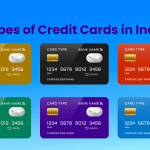Meet Riya, a young professional living in Mumbai who enjoys shopping online and dining out with friends. As someone who frequently uses her credit card, Riya started hearing about cashback credit cards and wondered if they could help her save money. After doing some research, she realized that cashback credit cards could provide a percentage of her spending back as a reward. But Riya, like many others, still had some questions: How do cashback credit cards work? What kind of benefits do they offer, and how can she make the most out of them?
If you’ve ever wondered the same, this blog post is for you. We’ll take a deep dive into how cashback credit cards work, their advantages, and how to use them wisely, especially in the Indian context. By the end of this guide, you’ll know if cashback credit cards are a good fit for your financial needs.
What are cashback credit cards?
In simple terms, cashback credit cards reward you for using your card by giving you back a percentage of the money you spend. This “cashback” can be redeemed later to reduce your outstanding bill, transferred to your bank account, or used for specific purchases.
Let’s go back to Riya. She uses her credit card regularly to pay for groceries, online shopping, and travel bookings. With a cashback credit card, every time she makes a transaction, she earns a small percentage of her spending back in the form of cashback. Over time, this cashback accumulates, offering real savings.
How do cashback credit cards work?
The basic concept behind cashback credit cards is simple: You spend money using your credit card, and the card issuer rewards you with cashback. However, there are different types of cashback programs, and understanding these will help you maximize your benefits. Let’s break down how cashback credit cards work in the Indian context:
1. Fixed Cashback Rate:
Some cashback credit cards offer a fixed percentage of cashback on all purchases, regardless of the category. For example, if Riya has a credit card that offers 1% cashback on every transaction, and she spends ₹10,000 on groceries, she will earn ₹100 as cashback.
2. Category-Based Cashback:
Other cards offer different cashback percentages based on specific categories like groceries, fuel, dining, or online shopping. For example, a card might offer 5% cashback on online shopping but only 1% cashback on other transactions. Riya’s card gives her 5% cashback on online shopping platforms like Amazon and Flipkart, while offering a lower rate on other spends.
3. Tiered Cashback:
Some cards offer tiered cashback rates, meaning the more you spend, the higher the cashback percentage you earn. For example, you may earn 1% cashback for spending up to ₹5,000, 2% for spending between ₹5,001 and ₹10,000, and 3% for spending over ₹10,000. For someone like Riya, who spends more during festive seasons, a tiered cashback card could help her earn more during periods of high spending.
4. Monthly or Annual Cashback Limits:
Most cashback credit cards have a cap on how much cashback you can earn in a month or year. Riya’s card, for example, offers up to ₹1,000 in cashback each month. Once she reaches that limit, she won’t earn any more cashback until the next billing cycle.
5. Cashback Redemption:
So, how does Riya actually get the cashback? Typically, the cashback amount is added to her credit card statement and can be used to offset her outstanding balance. In some cases, she can choose to transfer the cashback to her bank account or use it for specific purchases through the card’s rewards platform.
Recommended Read: Comparing Traditional Lenders vs. Online Lenders for Personal Loans
Advantages of using cashback credit cards in India
Now that you know how cashback credit cards work, let’s explore some of the benefits, particularly for Indian users:
1. Savings on Everyday Purchases:
One of the biggest advantages of cashback credit cards is that they help you save money on everyday transactions. Whether you’re buying groceries, paying utility bills, or booking a flight, cashback credit cards can offer real savings.
2. Flexibility in Spending:
Unlike rewards points, which often have to be redeemed for specific goods or services, cashback can be used directly to pay off your card balance or transferred to your bank account. This gives Riya more flexibility in how she uses her cashback.
3. Perfect for Online Shoppers:
In India, online shopping has become a significant part of daily life, and many cashback credit cards offer higher rates for e-commerce platforms. Riya frequently shops on Amazon and Myntra, so her cashback card helps her earn rewards on every purchase she makes online.
4. Hassle-Free Rewards:
Cashback credit cards are straightforward—there’s no need to worry about tracking reward points or redeeming them before they expire. With Riya’s card, she can easily see her cashback total in her monthly statement and know exactly how much she’s saved.
5. No Special Action Needed:
Once Riya has a cashback credit card, she doesn’t need to take any extra steps to earn rewards. Simply using the card for everyday transactions automatically gives her cashback.
How to maximize the benefits of cashback credit cards
Riya now understands how cashback credit cards work, but how can she make the most out of them? Here are a few strategies she follows:
1. Use the Card for Major Categories:
Riya uses her cashback credit card mainly for online shopping and groceries because these are the categories where she earns the highest cashback. By concentrating her spending in these areas, she maximizes the cashback she earns.
2. Track Monthly Cashback Limits:
Riya makes sure to monitor the monthly cashback limit on her card to ensure she doesn’t exceed it. If the card caps cashback at ₹1,000 per month, she keeps track of her spending so she can adjust her purchases accordingly.
3. Pay Off the Balance in Full:
To avoid interest charges, Riya always pays off her credit card balance in full each month. This way, the cashback she earns isn’t offset by hefty interest charges.
4. Take Advantage of Promotional Offers:
Sometimes, banks run promotional campaigns offering extra cashback for certain transactions or during festive seasons. Riya keeps an eye out for these offers and times her major purchases to take advantage of the additional cashback.
Is a cashback credit card right for you?
After learning how cashback credit cards work, Riya realized that this type of card was a perfect fit for her lifestyle. But cashback credit cards might not be the best option for everyone. If you tend to make a lot of small transactions across various categories, a general rewards card or a lifestyle credit card might suit you better.
However, if you spend a lot on categories that offer high cashback—like groceries, fuel, and online shopping—then a cashback credit card can provide significant savings.
Conclusion
Now that you know how cashback credit cards work, you can make an informed decision about whether they suit your lifestyle and spending patterns. For someone like Riya, cashback credit cards offer real savings on her everyday transactions, making them a smart choice for managing finances.
FAQs
1. How do cashback credit cards work?
Cashback credit cards reward you by giving back a percentage of your spending in the form of cashback. This cashback can be used to offset your outstanding credit card balance or be redeemed in other ways, depending on the card issuer.
2. Do cashback credit cards have limits on how much I can earn?
Yes, most cashback credit cards have a cap on how much cashback you can earn in a month or year. Be sure to check the terms of your card for any earning limits.
3. What types of spending typically earn cashback?
Cashback credit cards may offer cashback on various categories, such as groceries, fuel, online shopping, dining, and utility payments. Some cards offer a flat rate on all purchases, while others provide higher cashback on specific categories.
4. How can I redeem the cashback I earn?
Cashback is typically credited to your account and can be used to reduce your outstanding bill. Some credit cards also allow you to transfer the cashback to your bank account or use it for specific purchases through the bank’s rewards platform.
5. Is it better to use a cashback credit card or a rewards credit card?
It depends on your spending habits. If you prefer simple savings and use your card for everyday purchases, a cashback credit card is ideal. If you want more flexibility in redeeming points for travel, merchandise, or experiences, a rewards credit card might be better.



